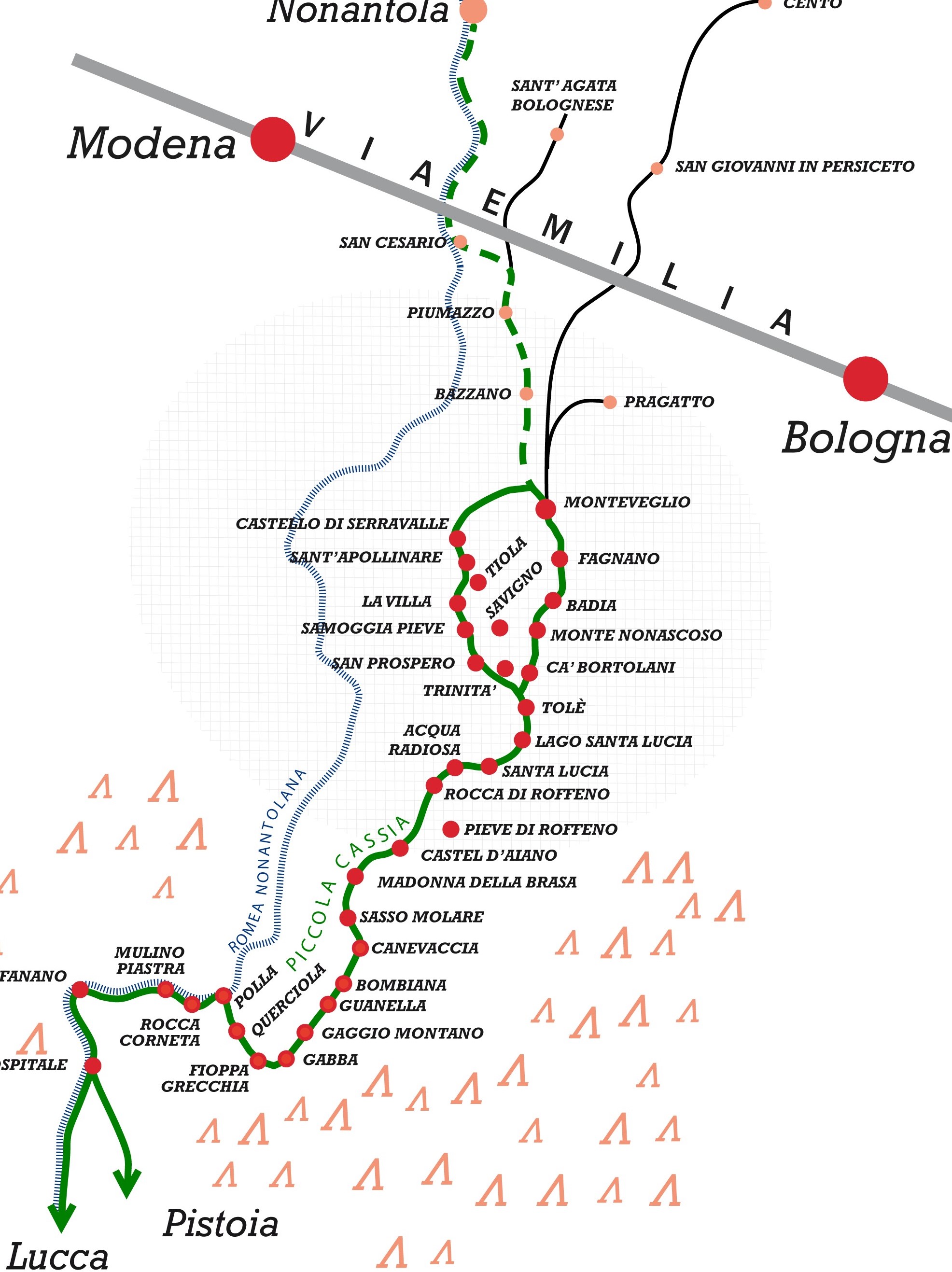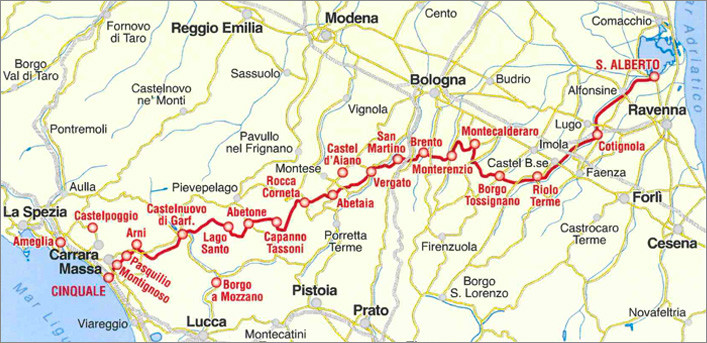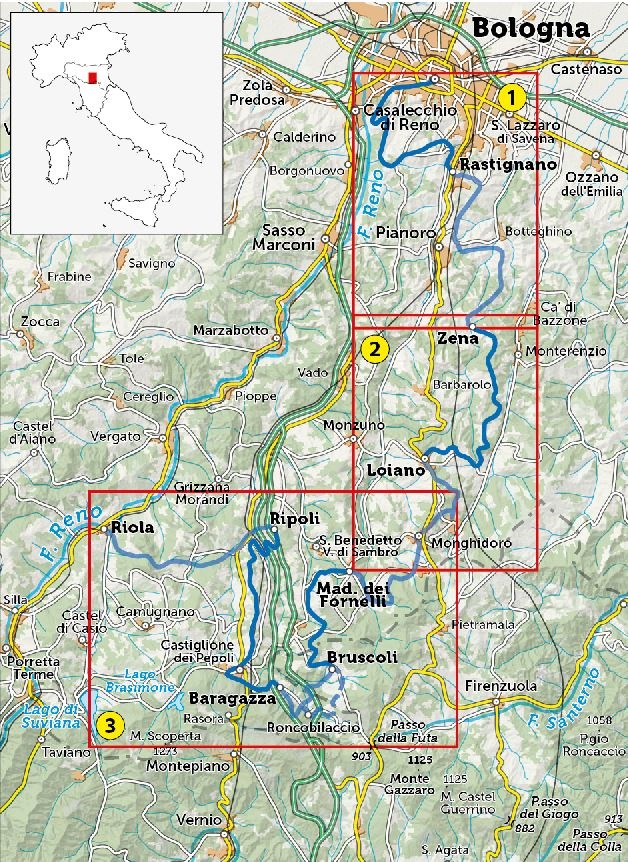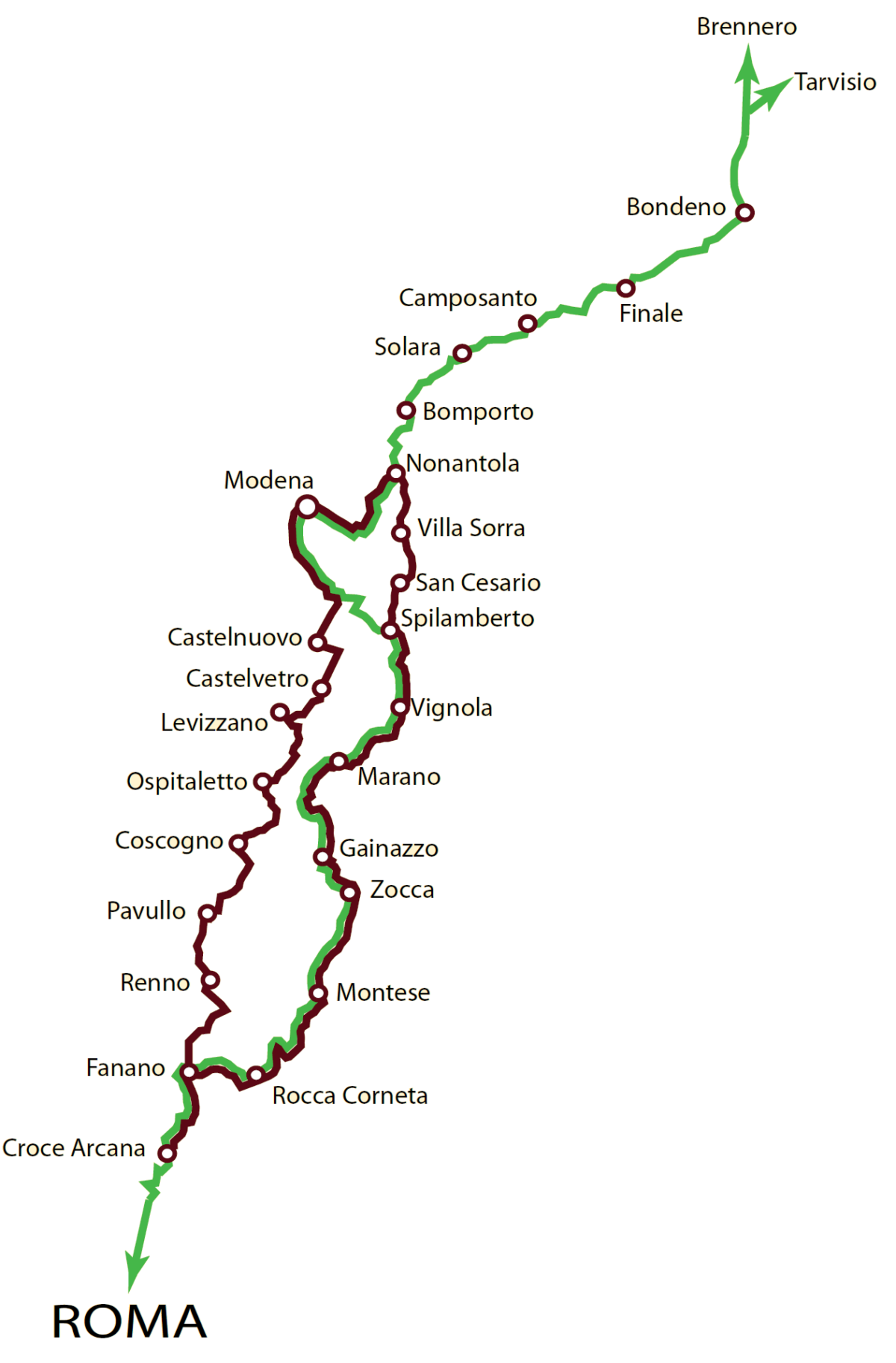
LITTLE CASSIA
The little Cassia, recently rediscovered and made passable, retraces that stretch of the Apennines that the Romans already used to reach the central Po Valley going up from Pistoia in the direction of Modena and Bologna. In the High Middle Ages it became a Longobard road and therefore one of the many itineraries that led to Rome joining up with the Via Francigena. Following it in a southerly direction (towards Rome) is an evocative journey, rich in many historical-religious testimonies (Nonantola Abbey, Rocca di Bazzano, Monteveglio Abbey, Castle of Serravalle and S. Apollinare, Badia, Santa Lucia and Pieve di Roffeno, Bombiana, Rocca Corneta, Fanano and many other historic centers and villages) and characterized by a particularly interesting rural and natural landscape (from the fertile centuriated plain, to the hills of gullies and vineyards, to the severe woods and large prairies of the Apennine ridge). Walking slowly along this path you can have an important cultural experience, an intimate spiritual experience and, no less important, a tasty gastronomic experience: we are in fact in the lands of Parmigiano Reggiano, typical Modena and Bolognese cold cuts, pignoletto wine and many mountain specialties still little known.

GOTHIC LINE, THE MEMORY OF THE APENNINES
The Gothic Line Walk is a proposal that aims to combine the pleasure of sporting activity in nature with the desire to learn more about a past that represents, albeit tragically, the melting pot of those behaviours, ideas and values from which the Italian Constitution was born . If on the one hand, therefore, there is the pleasure of walking in the countryside, on paths, mule tracks, carriageways (and short stretches of provincial roads with little traffic), on the other - taking up the invitation of Piero Calamandrei ("If you want go on pilgrimage to the place where our Constitution was born, go to the mountains where the partisans fell"), is to be considered precisely a secular pilgrimage, devoted to that civil religion which, unfortunately, has never been cultivated in Italy enough. For this reason, the Way touches both the heart of the Gothic Line (where the fortifications were built and the Germans and Allies clashed), as well as the places of destruction and massacres and, last but not least, the places where women and men of the Resistance, often sacrificing their lives, they fought against the occupiers and – redeeming the shame of fascist Italy – they laid the moral foundations of republican Italy. It cannot be forgotten: the democracy we enjoy today was born here, from the tenacity of those who resisted barbarism and contributed to the triumph of the values of justice, freedom and equality.

VIA MATER DEI, THE STREET OF THE MARIAN SANCTUARIES
The Via Mater Dei is the path dedicated to the Marian Sanctuaries of the Bolognese Apennines. It is a route of about 157 km which develops in seven stages on mid-mountain ridges and which connects the city of Bologna to nine municipalities in the Bolognese Apennines: Pianoro, Monterenzio, Loiano, Monghidoro, San Benedetto Val di Sambro, Castiglione dei Pepoli , Camugnano, Grizzana Morandi, Vergato and the Municipality of Firenzuola, in the Tuscan territory. From the City, with its walls and medieval monuments so famous in the world slowly, walking and sweating, you will be able to rediscover that natural contact with the earth, the wind, the sun, the rain which are the casual but essential elements of a real journey. Step by step, arriving at the last sanctuary, once you return to the city, whatever City you live in, everything will have a new face, because your looks will be new.

VIA ROMEA NONANTOLANA/LONGOBARDA, HISTORIC ROAD FROM THE ALPS TO ROME
The Via Romea Nonantolana rediscovers a historic path that for over 12 centuries has connected northern Italy and central Europe with Rome, across the Po valley and the Tuscan-Emilian Apennines. The pivot of the route has always been the Nonantola Abbey which, together with Cluny and Canterbury was among the most important and powerful Benedictine abbeys in Europe, an obligatory passage for Popes, emperors, armies, merchants and above all pilgrims. The pilgrim and the wayfarer of the 21st century arrive today in our territory through the "Nonantolana-Lombard" Romea Strata, which connects the Alpine passes of the Brennero and Tarvisio up to the Po and Nonantola. From here you can choose the western route towards Modena and Castelnuovo, and then go up to Castelvetro, Levizzano, Ospitaletto, Pavullo and finally reach Fanano, or opt for the eastern route, towards San Cesario and its beautiful Romanesque church, and then join to the Romea Strata route in Spilamberto. In Fanano the right and left Panaro branches of the Romea Nonantolana reunite. Once in Ospitale, however, it is possible to choose the variant in the direction of Lake Scaffaiolo and Passo della Calanca, covering some of the best preserved and most evocative stretches of the ancient path. Then continue towards Pistoia, to then connect to the Via Francigena at Fucecchio-San Illuminated. However, the two sections of the Via Romea Nonantolana can also be read as a ring itinerary that can be covered in 7-10 days on foot.